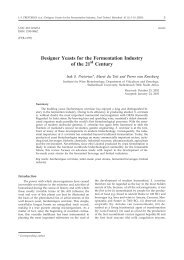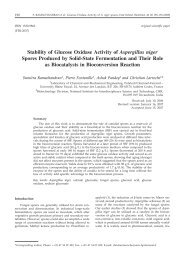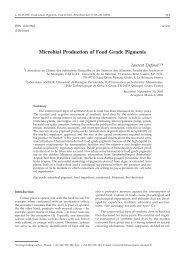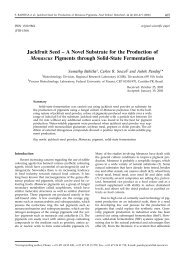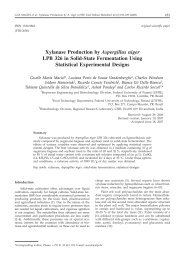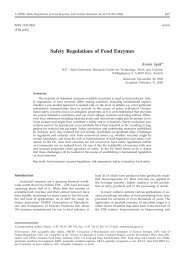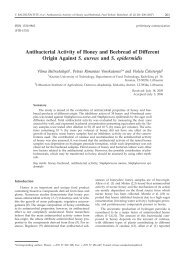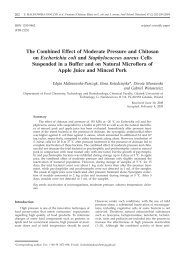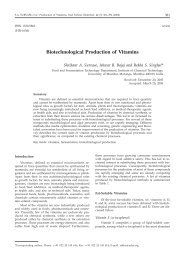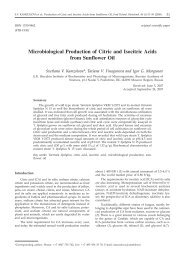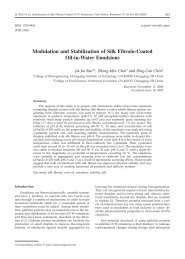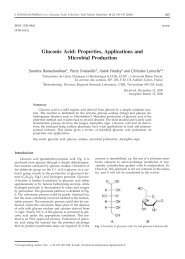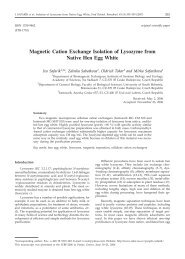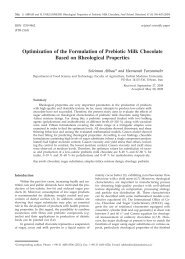A Review - Food Technology and Biotechnology
A Review - Food Technology and Biotechnology
A Review - Food Technology and Biotechnology
You also want an ePaper? Increase the reach of your titles
YUMPU automatically turns print PDFs into web optimized ePapers that Google loves.
374 B. KOSIN <strong>and</strong> S.K. RAKSHIT: Criteria for Production of Probiotics, <strong>Food</strong> Technol. Biotechnol. 44 (3) 371–379 (2006)<br />
strains (30). The changes in lipid composition enable the<br />
microorganisms to maintain membrane functions in the<br />
face of environmental fluctuations. In particular, temperature-induced<br />
variations in lipid composition of bacteria<br />
are generally thought to be associated with the regulation<br />
of liquid crystalline to gel phase transition temperature<br />
for the maintenance of an ideal »functional« physiological<br />
state of cell membrane.<br />
Interest in the stress response phenomenon of LAB<br />
species has grown (26,37). Underst<strong>and</strong>ing the mechanism<br />
of stress may lead to the development of cultures<br />
with improved capacity to survive <strong>and</strong> function under<br />
industrial production conditions. Examination of the<br />
increased degree of thermotolerance <strong>and</strong> suitability for<br />
spray drying conferred on probiotics by adaptation to<br />
different stresses is another challenging step being addressed.<br />
In addition, the effects of various rehydration<br />
conditions on culture performance should be taken into<br />
account, given that resuscitation of dried cultures may<br />
represent a critical control point in obtaining effective<br />
probiotic strains.<br />
Probiotic Selection, Isolation <strong>and</strong><br />
Methodology Development<br />
Since genetic stability is also required in probiotics,<br />
isolated specified target of functional strain needs to be<br />
identified. LAB belonging to the genus Lactobacillus have<br />
been isolated from a variety of habitats, including plant<br />
<strong>and</strong> dairy products, meat products, sewage <strong>and</strong> manure,<br />
<strong>and</strong> humans <strong>and</strong> animals. Several isolates from animal<br />
host like chicken were found to be acid <strong>and</strong> bile tolerant<br />
(45–47). Although several Lactobacillus spp. have been<br />
isolated from chicken faeces, most of the strains isolated<br />
so far have been mesophiles. However, the isolation of<br />
Lactobacillus spp. from chicken faeces under high temperatures<br />
has been studied <strong>and</strong> reported by Niamsup et<br />
al. (30). In their studies, they isolated a large number of<br />
LAB from various types of natural samples at relatively<br />
high temperatures, i.e. 40–50 °C. A recent study (48) used<br />
species <strong>and</strong> group-specific 16S rRNA-targeted oligonucleotide<br />
probes, dot blot hybridization (DNA-DNA hybridization)<br />
<strong>and</strong> fluorescent in situ hybridization (FISH)<br />
methods. The probes were designed in a way that some<br />
of the T-LAB detect novel species of L. thermotolerans<br />
<strong>and</strong> other LAB in chicken faeces. FISH analysis performed<br />
with group-specific 16S rRNA-targeted oligonucleotide<br />
probes was also successively used to analyze<br />
the fecal microflora of host consuming probiotic product<br />
containing specific lactobacilli (48).<br />
The use of PCR assay (polymerase chain reaction)<br />
method with the 16S rRNA analysis has been studied in<br />
many works on identification of organisms isolated from<br />
chicken host, human faeces <strong>and</strong> animal feed (49–52). A<br />
new real-time quantitative PCR with 16S rRNA gene-targeted<br />
species/group-specific primers has recently been<br />
introduced to analyze LAB in intestine <strong>and</strong> faeces of human<br />
host (53–55). A real-time PCR assay for rapid <strong>and</strong><br />
sensitive detection of a novel thermotolerant bacterium,<br />
Lactobacillus thermotolerans, in chicken faeces was developed<br />
<strong>and</strong> assessed by Selim et al. (56). Whole-cell protein<br />
profiling method by SDS PAGE is an additional studied<br />
method to help identify a new thermotolerant<br />
species of LAB isolated from chicken faeces (31) <strong>and</strong> to<br />
identify the isolates from 55 European probiotic products<br />
(57).<br />
A novel multiplex polymerase chain reaction (PCR)<br />
primer set for the identification of a number of probiotic<br />
Lactobacillus species simultaneously has been developed<br />
(58). It uses the primer sets comprising of specific <strong>and</strong><br />
two conserved primers derived from the integrated sequences<br />
of 16S <strong>and</strong> 23S rRNA genes <strong>and</strong> their rRNA<br />
intergenic spacer region of each species with 93.6 % accuracy.<br />
This exceeds the accuracy of the general biochemical<br />
methods. The phylogenetic analyses, using 16S<br />
rDNA sequences of the probiotic isolates, also provided<br />
further support that the results from the multiplex PCR<br />
assay were trustworthy. The results suggested that the<br />
multiplex primer set of PCR is an efficient tool for simple,<br />
rapid <strong>and</strong> reliable identification of seven Lactobacillus<br />
species.<br />
Adhesion/colonization<br />
Adhesion <strong>and</strong> colonization are important for selection<br />
<strong>and</strong> use of probiotic strains. Scanning electron microscope<br />
(SEM) has been introduced to study the density<br />
<strong>and</strong> survival of probiotics in chicken intestine after feeding<br />
chicken with the probiotic supplements (59). Different<br />
methods are used to study bacterial adhesion to intestinal<br />
epithelial cells, which is an important step in<br />
pathogenic infection as well as in probiotic colonization<br />
of the intestinal tract. Le Blay et al. (60) conducted comparative<br />
detection of bacterial adhesion to Caco-2 cells<br />
with ELISA, radioactivity <strong>and</strong> plate count methods. The<br />
methods tested gave similar results for the highest bacterial<br />
concentrations. However, differences among methods<br />
increased with the addition of decreased bacterial<br />
concentration due to different detection thresholds. The<br />
ELISA-based method was shown to be a good predictor<br />
for bacterial adhesion compared to the radiolabelling<br />
method when good quality specific antibodies were used.<br />
This technique is convenient <strong>and</strong> allows h<strong>and</strong>ling of numerous<br />
samples. Fluorescent staining of Lactobacillus<br />
<strong>and</strong> Bifidobacterium strains <strong>and</strong> a Bifidobacterium mixture<br />
using the viable probe carboxyfluorescein diacetate was<br />
attempted. These cells were incubated on Caco-2 monolayers<br />
<strong>and</strong> subsequent spectrofluorimetric detection following<br />
the lysis of the attached bacterial cells was done.<br />
The results were expressed as adhesion percentage (61),<br />
<strong>and</strong> they proved that fluorescent labelling is suitable for<br />
adhesion studies <strong>and</strong> provides a reliable <strong>and</strong> safer alternative<br />
to radioactive labelling.<br />
Immune response<br />
Transmission electron microscopy (TEM) was used<br />
to determine how probiotic strains in contact with intestinal<br />
epithelia result in an immune response in mice (10).<br />
Development <strong>and</strong> validation of a new in vitro assay for<br />
selection of probiotic bacteria that express immune-stimulating<br />
properties in chickens in vivo was studied by Koenen<br />
et al. (62). They used an in vitro system for rapid<br />
preselection of LAB with immunomodulating properties.<br />
For T-cell proliferation following mitogenic stimulation,<br />
activation of accessory cells is required. The pre-selection<br />
assay was based on a concanavalin A (ConA)



